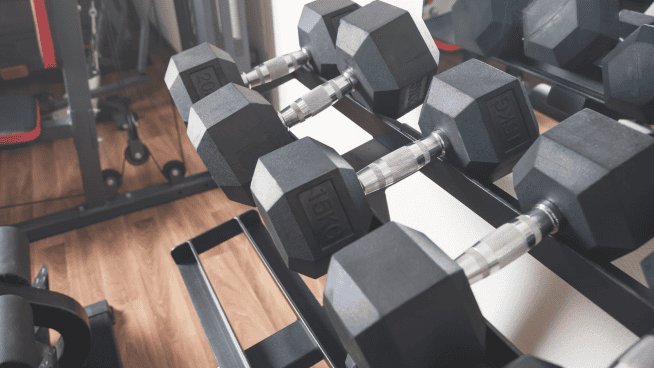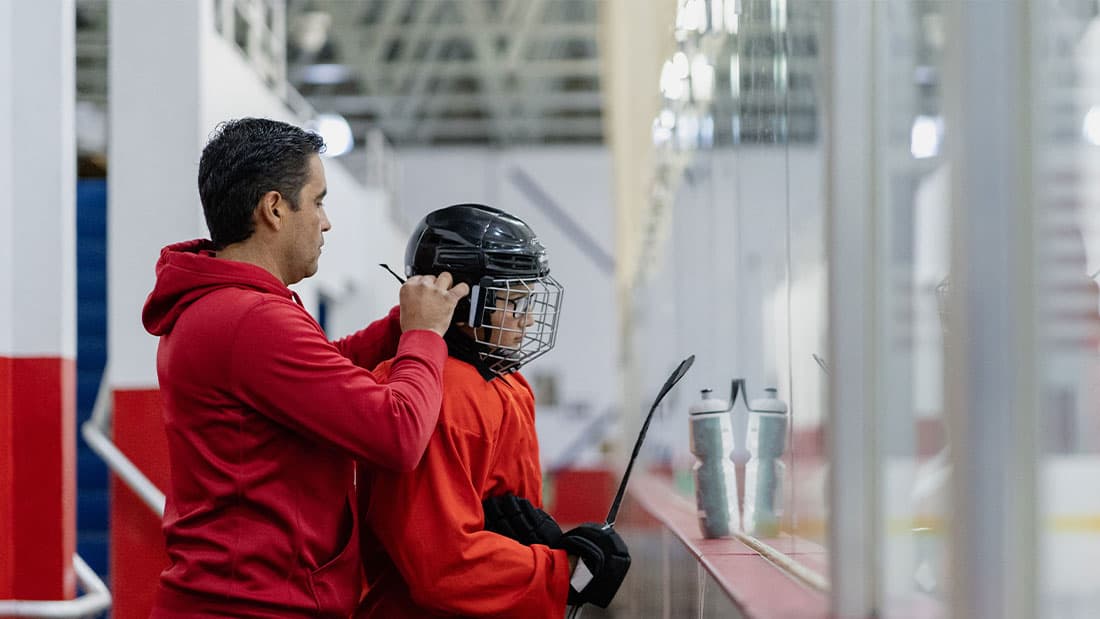Improve Your Pitching Accuracy With These Core Exercises
A baseball pitcher with clean, efficient mechanics is a strong candidate for professional success. But getting to that point isn’t easy. Delivering an accurate, fast pitch requires different components of the body to work in sync in a very short period of time. This requires core exercises for pitchers that promote strength, agility and balance.
Being dynamically balanced from start to finish allows you to maximize your potential energy, starting at your feet and ending with your hands. Potential energy transfers into kinetic energy, which powers an explosive pitch by transmitting force from one joint to another in succession across your body’s kinetic chain.
RELATED: Increase Your Pitching Velocity With These 3 Exercises
Mechanical tweaks can refine a player’s game. However, lower-body and core training are important for maximizing performance and reducing injury risk. If you do not have the necessary strength, stability and mobility, you will not physically be able to improve your mechanics.
Reducing Injury Risk
Muscular weakness and range-of-motion limitations increase upper-body compensation. Undertrained muscles result in a weak link across the kinetic chain, thereby increasing forces at the shoulder and elbow (and raising the risk of injury), but decreasing velocity and accuracy.
Improving Performance
During the pitch, energy transfers from the lower to the upper body. Generated from the ground up, this energy is referred to as “ground reaction force”—and it is essential. The resistance of pushing off the ground transfers energy into your legs, then into your torso as you stride forward and rotate your body to pitch.
Your trunk contributes an estimated 50 percent of the kinetic energy and force production during the throwing motion. Torso rotation strongly influences what happens at the shoulder.
RELATED: 3 Explosive Exercises Designed to Increase Pitching Power
Biomechanically efficient body movements from the lower body and core also maximize arm speed, as the energy moves into your arms and hands. Research has demonstrated a positive relationship between ground reaction force and wrist speed. The result? The ball explodes into the zone with greater accuracy.
Exercises
Elevated Split Squat (a.k.a. Bulgarian Split Squat)
- Improves hip mobility and gluteal and quad strength for your stride leg.
- Improves stability / balance at ankle, knee and hip joints.
- Improves triple extension, which has been shown to improve velocity.
How To: (see video for demonstration)
- Hold a medicine ball or kettlebell under your chin.
- With your rear foot elevated at a higher level than your lead foot, drop down to more than 90 degrees (ideally ~100-110 degrees).
Coaching Points:
- Start with you body weight and progress to holding a medicine ball or kettlebell.
- Think “tall and strong.” Do not lean forward at the waist.
- To improve coordination and timing, progress to an overhead Medicine Ball Throw
Sets/Reps: Start with 2-3 sets of 8-10 reps.
Medicine Ball Skaters (Side Bounds)
This is an excellent dynamic exercise for baseball pitchers. It combines strength, stability, mobility, power and timing. A lot goes on in this movement, so take your time and get it right. (see tips below)
- Core strength, especially the transverse abdominis (your side muscles)—a necessary component for rotational power.
- Dynamic leg strength, especially at the hip musculature (including abductors and glutes). Hip abduction strength (provided by glute medius) allows you to maintain your center of gravity and prevent downward pelvic tilt. This is essential both for optimal power production and injury prevention.
- Mobility (especially at hip and adductors), great for increasing stride length. An longer stride length increases the velocity of your pitch without affecting accuracy.
- Stability at the ankle, knee and hip.
- Power development. Through an optimal combination of muscle contraction force and velocity, there is a greater potential increase of type II muscle fiber recruitment (your “fast twitch” explosive fibers), motor unit firing, and synchronicity. If this sounds confusing, just know that it is all good stuff to increase your power!
- Timing
How To:
- Start standing in an athletic stance (feet under hips).
- Explode sideways to a Lateral Bound and simultaneously rotate the medicine ball to the opposite side.
- Pause for approximately 1 second (“stick the landing”) then repeat to the other side.
Coaching Points:
- Explosive Lateral Bound. You should be jumping sideways as far as possible. Use your standing leg to push off.
- Landing: Foot, knee, hip in alignment.
- Rotating the medicine ball “with the core.”
Sets/Reps: 3-4 sets of 8-12 reps (4-6/side)
RELATED: Baseball Training: How to Throw Strikes Consistently
Plank to Side Plank
- Core strength, especially at the abdominal and hip regions, including the transverse abdominis.
- Body working as a unit, reducing breakdown within the abdominal and hip region.
- Assume a plank position with your forearms on the ground and elbows under your shoulders.
- Rotate to your left and move into a Side Plank.
- Rotate back to Plank, and then to a Side Plank on the opposite side.
- Keep your core tight and back flat
- Your elbows should always be under your shoulders
- Rotate your entire torso and hips, not just through your lower back
References:
Crotin, R. (201). “Functional lower body strength and conditioning exercises for baseball pitchers: a current overview of lower body training for baseball pitchers.” National Strength and Conditioning Association Performance Training Journal, 10(2), 8-10.
Dodd, D. J., & Alvar. B. A. (2007). “Analysis of acute explosive training modalities to improve lower-body power in baseball players.” Journal of Strength and Conditioning Research, 21(4), 1177-1182.
Fleisig, GS., Escamilla, RF., & Barrentine, SW. (1998). “Biomechanics of pitching: Mechanism and throwing analysis.” Injuries in Baseball: Philadelphia: Lippincott-Raven Publishers.
Fortenbaugh, D., Fleisig, G. S., & Andrews, J. R. (2009). “Baseball pitching mechanics in relation to injury risk and performance.” Sports Health, 1(4), 314-320.
MacWilliams, B. A., Choi, T., Perezous, M. K., Chao, E. Y. S. & McFarland, E. G. (1998). “Characteristic ground-reaction forces in baseball pitching.” The American Journal of Sports Medicine, 26(1), 66-71.
McGinnis, P. (2013). Biomechanics of Sport and Exercise, 3nd Ed. Human Kinetics: Champaign, IL.
Oliver, G. D., & Keeley, D. W., (2010). “Pelvis and torso kinematics and their relationship to shoulder kinematics in high-school baseball pitchers.” Journal of Strength and Conditioning Research, 24(12), 3241-3246.
Wilke, K. E., Yenchak, A. J., Arrigo, C. A., & Andrews, J. R. (2011). “The advanced throwers ten exercise program: A new exercise series for enhanced dynamic shoulder control in the overhead throwing athlete.” The Physician and Sports Medicine, 39(4), 90-97.
Yamanouchi, T. (1998). “EMG analysis of the lower extremities during pitching in high school baseball.” Kurume Medical Journal, 45(1), 21-25.
[cf]skyword_tracking_tag[/cf]RECOMMENDED FOR YOU
MOST POPULAR
Improve Your Pitching Accuracy With These Core Exercises
A baseball pitcher with clean, efficient mechanics is a strong candidate for professional success. But getting to that point isn’t easy. Delivering an accurate, fast pitch requires different components of the body to work in sync in a very short period of time. This requires core exercises for pitchers that promote strength, agility and balance.
Being dynamically balanced from start to finish allows you to maximize your potential energy, starting at your feet and ending with your hands. Potential energy transfers into kinetic energy, which powers an explosive pitch by transmitting force from one joint to another in succession across your body’s kinetic chain.
RELATED: Increase Your Pitching Velocity With These 3 Exercises
Mechanical tweaks can refine a player’s game. However, lower-body and core training are important for maximizing performance and reducing injury risk. If you do not have the necessary strength, stability and mobility, you will not physically be able to improve your mechanics.
Reducing Injury Risk
Muscular weakness and range-of-motion limitations increase upper-body compensation. Undertrained muscles result in a weak link across the kinetic chain, thereby increasing forces at the shoulder and elbow (and raising the risk of injury), but decreasing velocity and accuracy.
Improving Performance
During the pitch, energy transfers from the lower to the upper body. Generated from the ground up, this energy is referred to as “ground reaction force”—and it is essential. The resistance of pushing off the ground transfers energy into your legs, then into your torso as you stride forward and rotate your body to pitch.
Your trunk contributes an estimated 50 percent of the kinetic energy and force production during the throwing motion. Torso rotation strongly influences what happens at the shoulder.
RELATED: 3 Explosive Exercises Designed to Increase Pitching Power
Biomechanically efficient body movements from the lower body and core also maximize arm speed, as the energy moves into your arms and hands. Research has demonstrated a positive relationship between ground reaction force and wrist speed. The result? The ball explodes into the zone with greater accuracy.
Exercises
Elevated Split Squat (a.k.a. Bulgarian Split Squat)
- Improves hip mobility and gluteal and quad strength for your stride leg.
- Improves stability / balance at ankle, knee and hip joints.
- Improves triple extension, which has been shown to improve velocity.
How To: (see video for demonstration)
- Hold a medicine ball or kettlebell under your chin.
- With your rear foot elevated at a higher level than your lead foot, drop down to more than 90 degrees (ideally ~100-110 degrees).
Coaching Points:
- Start with you body weight and progress to holding a medicine ball or kettlebell.
- Think “tall and strong.” Do not lean forward at the waist.
- To improve coordination and timing, progress to an overhead Medicine Ball Throw
Sets/Reps: Start with 2-3 sets of 8-10 reps.
Medicine Ball Skaters (Side Bounds)
This is an excellent dynamic exercise for baseball pitchers. It combines strength, stability, mobility, power and timing. A lot goes on in this movement, so take your time and get it right. (see tips below)
- Core strength, especially the transverse abdominis (your side muscles)—a necessary component for rotational power.
- Dynamic leg strength, especially at the hip musculature (including abductors and glutes). Hip abduction strength (provided by glute medius) allows you to maintain your center of gravity and prevent downward pelvic tilt. This is essential both for optimal power production and injury prevention.
- Mobility (especially at hip and adductors), great for increasing stride length. An longer stride length increases the velocity of your pitch without affecting accuracy.
- Stability at the ankle, knee and hip.
- Power development. Through an optimal combination of muscle contraction force and velocity, there is a greater potential increase of type II muscle fiber recruitment (your “fast twitch” explosive fibers), motor unit firing, and synchronicity. If this sounds confusing, just know that it is all good stuff to increase your power!
- Timing
How To:
- Start standing in an athletic stance (feet under hips).
- Explode sideways to a Lateral Bound and simultaneously rotate the medicine ball to the opposite side.
- Pause for approximately 1 second (“stick the landing”) then repeat to the other side.
Coaching Points:
- Explosive Lateral Bound. You should be jumping sideways as far as possible. Use your standing leg to push off.
- Landing: Foot, knee, hip in alignment.
- Rotating the medicine ball “with the core.”
Sets/Reps: 3-4 sets of 8-12 reps (4-6/side)
RELATED: Baseball Training: How to Throw Strikes Consistently
Plank to Side Plank
- Core strength, especially at the abdominal and hip regions, including the transverse abdominis.
- Body working as a unit, reducing breakdown within the abdominal and hip region.
- Assume a plank position with your forearms on the ground and elbows under your shoulders.
- Rotate to your left and move into a Side Plank.
- Rotate back to Plank, and then to a Side Plank on the opposite side.
- Keep your core tight and back flat
- Your elbows should always be under your shoulders
- Rotate your entire torso and hips, not just through your lower back
References:
Crotin, R. (201). “Functional lower body strength and conditioning exercises for baseball pitchers: a current overview of lower body training for baseball pitchers.” National Strength and Conditioning Association Performance Training Journal, 10(2), 8-10.
Dodd, D. J., & Alvar. B. A. (2007). “Analysis of acute explosive training modalities to improve lower-body power in baseball players.” Journal of Strength and Conditioning Research, 21(4), 1177-1182.
Fleisig, GS., Escamilla, RF., & Barrentine, SW. (1998). “Biomechanics of pitching: Mechanism and throwing analysis.” Injuries in Baseball: Philadelphia: Lippincott-Raven Publishers.
Fortenbaugh, D., Fleisig, G. S., & Andrews, J. R. (2009). “Baseball pitching mechanics in relation to injury risk and performance.” Sports Health, 1(4), 314-320.
MacWilliams, B. A., Choi, T., Perezous, M. K., Chao, E. Y. S. & McFarland, E. G. (1998). “Characteristic ground-reaction forces in baseball pitching.” The American Journal of Sports Medicine, 26(1), 66-71.
McGinnis, P. (2013). Biomechanics of Sport and Exercise, 3nd Ed. Human Kinetics: Champaign, IL.
Oliver, G. D., & Keeley, D. W., (2010). “Pelvis and torso kinematics and their relationship to shoulder kinematics in high-school baseball pitchers.” Journal of Strength and Conditioning Research, 24(12), 3241-3246.
Wilke, K. E., Yenchak, A. J., Arrigo, C. A., & Andrews, J. R. (2011). “The advanced throwers ten exercise program: A new exercise series for enhanced dynamic shoulder control in the overhead throwing athlete.” The Physician and Sports Medicine, 39(4), 90-97.
Yamanouchi, T. (1998). “EMG analysis of the lower extremities during pitching in high school baseball.” Kurume Medical Journal, 45(1), 21-25.
[cf]skyword_tracking_tag[/cf]









